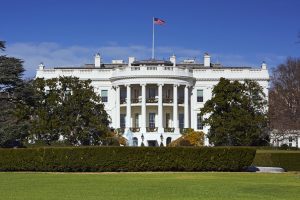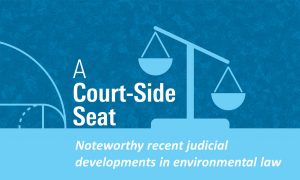A Florida home for sale offers a property deed via an NFT, nuclear power is projected to play an important role in the climate crisis, a Spanish real estate developer aims to set up an office in the the metaverse Decentraland, and more.
Articles Posted in Environmental
EPA Announces Increased Efforts to Require Cleanup of Coal Ash – Insurance Should Be a Component of Companies’ Response
On January 11, 2022, the U.S. Environmental Protection Agency (EPA) issued a press release announcing “key steps” it is taking to “protect groundwater from coal ash contamination.” Pillsbury attorney Matthew Jeweler recently authored the post, “EPA Announces Increased Efforts to Require Cleanup of Coal Ash – Insurance Should Be a Component of Companies’ Response,” discussing the insurance implications resulting from the Biden Administration’s new regulatory priorities. Continue Reading ›
The EPA and the Corps of Engineers Propose Another Revised Definition of “Waters of the United States”
On December 7, 2021, the most recent proposed revision to the Clean Water Act’s term, “Waters of the United States” was published in the Federal Register. (See 86 FR 69372.) Comments on this proposal must be submitted by February 7, 2022. This term controls the scope of federal regulatory powers in such programs as the development of water quality standards, impaired waters, total maximum daily loads, oil spill prevention, preparedness and response plans, state and tribal water quality certification programs, the National Pollutant Discharge Elimination System (NPDES) permit program, and the Corps of Engineers’ dredge and fill program. The Environmental Protection Agency (EPA) and the Corps of Engineers have jointly drafted this comprehensive proposed rule, which also responds to President Biden’s Executive Order 13990, issued in January 2021.
A Year-End Review of the Environmental Regulatory Landscape
Anne Austin recently joined Industry Insights host Joel Simon to discuss the key considerations and drivers of the Biden administration’s major regulatory initiatives.
 Our guest today is Anne Idsal Austin, a nationally recognized environmental lawyer who has held several high-profile federal and state regulatory roles. As a partner who recently joined Pillsbury’s environmental and natural resources practice, she provides strategic consulting and policy advice, helping clients navigate the dynamic regulatory and legal waters in an era of energy transition, decarbonization and an emphasis on ESG principles. Prior to joining Pillsbury, Anne was the Principal Deputy Assistant Administrator for the U.S. Environmental Protection Agency’s Office of Air and Radiation, known as OAR or OAR, where she had primary oversight over United States clean air policy and regulation. Prior to that, she served as the EPA regional administrator for Region 6, overseeing all federal environmental programs in Texas, Louisiana, New Mexico, Oklahoma and Arkansas. Prior to joining EPA, Anne held several positions where she shaped environmental and energy policy at the highest levels of government in the state of Texas. Welcome to our podcast, Anne.
Our guest today is Anne Idsal Austin, a nationally recognized environmental lawyer who has held several high-profile federal and state regulatory roles. As a partner who recently joined Pillsbury’s environmental and natural resources practice, she provides strategic consulting and policy advice, helping clients navigate the dynamic regulatory and legal waters in an era of energy transition, decarbonization and an emphasis on ESG principles. Prior to joining Pillsbury, Anne was the Principal Deputy Assistant Administrator for the U.S. Environmental Protection Agency’s Office of Air and Radiation, known as OAR or OAR, where she had primary oversight over United States clean air policy and regulation. Prior to that, she served as the EPA regional administrator for Region 6, overseeing all federal environmental programs in Texas, Louisiana, New Mexico, Oklahoma and Arkansas. Prior to joining EPA, Anne held several positions where she shaped environmental and energy policy at the highest levels of government in the state of Texas. Welcome to our podcast, Anne.
Anne Austin: Thanks so much. It’s great to be here today, Joel.
Environmental Regulatory Provisions Embedded in the Infrastructure Investment and Jobs Act
With the enactment of this important legislation, its impact on environmental regulation and policy will be carefully analyzed by the regulated community. Such a review may be hampered by the fact that the law is not only complex but also very long (over 2000 pages!). The Infrastructure Act is mostly an appropriations and authorization law, but it includes many new policy choices. This is a brief review (which can only scratch the surface of this law) of some of the many environmentally related provisions, which are part of this new law and can be located in the pdf version of the law.
Eco Oro v. Colombia and the Police Powers Exception: What Companies Should Know When Investing Outside of Their Country
 In a mixed decision for international investors, the International Centre for Settlement of Investment Disputes (ICSID) recently published a tribunal’s award finding that the Republic of Colombia breached its obligations under the Canada-Colombia Free Trade Agreement when it blocked Eco Oro Minerals Corporation’s mining project in an effort to protect a high-altitude wetland known as the Santurbán Páramo but held that Colombia did not indirectly expropriate Eco Oro’s concession contract with the government pursuant to which Eco Oro’s investment was made because its actions were a legitimate exercise of Colombia’s right as sovereign state to protect its environment. ICSID arbitration, as its name implies, exclusively deals with international commercial disputes, where “investors” (as defined by applicable treaties and include both companies and individuals) submit claims under international treaties against foreign governments. The Eco Oro decision and its underlying analysis are not unique to investor-state arbitration and illustrate how domestic policy concerns, such as the protection of the environment, may result in States acting against the interests of foreign commercial investment.
In a mixed decision for international investors, the International Centre for Settlement of Investment Disputes (ICSID) recently published a tribunal’s award finding that the Republic of Colombia breached its obligations under the Canada-Colombia Free Trade Agreement when it blocked Eco Oro Minerals Corporation’s mining project in an effort to protect a high-altitude wetland known as the Santurbán Páramo but held that Colombia did not indirectly expropriate Eco Oro’s concession contract with the government pursuant to which Eco Oro’s investment was made because its actions were a legitimate exercise of Colombia’s right as sovereign state to protect its environment. ICSID arbitration, as its name implies, exclusively deals with international commercial disputes, where “investors” (as defined by applicable treaties and include both companies and individuals) submit claims under international treaties against foreign governments. The Eco Oro decision and its underlying analysis are not unique to investor-state arbitration and illustrate how domestic policy concerns, such as the protection of the environment, may result in States acting against the interests of foreign commercial investment.
A Court-Side Seat: OSHA, Air and Waters
The courts have issued several new and significant rulings on environmental and administrative law the past few weeks.
U.S. COURT OF APPEALS FOR THE DISTRICT OF COLUMBIA CIRCUIT
Truck Trailer Manufacturers Association, Inc. v. EPA
On November 12, 2021, the DC Circuit held in a divided ruling that neither Section 202(a)(1) of the Clean Air Act nor the Energy Independence and Security Act of 2017 authorized these agencies to regulate the greenhouse gas emissions released by trailers pulled by tractors—most commonly, the 18 wheelers that carry many products to market on the nation’s highways. According to the court, trailers have no motor, and therefore cannot be subject to the Greenhouse emissions and fuel efficiency standards promulgated in 2016. (See 81 FR 73478.) The majority, after an exacting review of these statutes, determined that the Clean Air Act did not authorize that portion of EPA’s rule insofar as it applies to heavy-duty trailers, and since the Energy Independence Act concentrates on fuel economy, and trailers use no fuel, there was also no authority for the NHTSA to employ. Judge Millett agreed with the majority regarding the EPA rules but would hold that the NHTSA’s inclusion of commercial trailers in its fuel efficiency rule was a reasonable interpretive judgment that “falls squarely within its statutory delegation.”
Real Estate & Construction News Round-Up (11/17/21)
President Biden signs the bipartisan infrastructure bill into law, plants like hemp and algae could help minimize the environmental footprint of high-rise buildings, construction groups sue over the Occupational Safety and Health Administration’s (OSHA) new vaccine rule, and more.
A Court-Side Seat: Rulemaking Proposed, Comments Solicited
We interrupt our usual scrutiny of the courts to focus (mostly) on the important developments in notices and rulemaking issued by and concerning federal regulatory agencies and departments in the past several weeks.
Real Estate & Construction News Round-Up (11/10/21)
The House of Representatives passes the Senate version of the Infrastructure Investment and Jobs Act (IIJA), the construction industry continues to struggle with labor shortages, effects of climate change put the built environment at risk, and more.
 Gravel2Gavel Construction & Real Estate Law Blog
Gravel2Gavel Construction & Real Estate Law Blog



